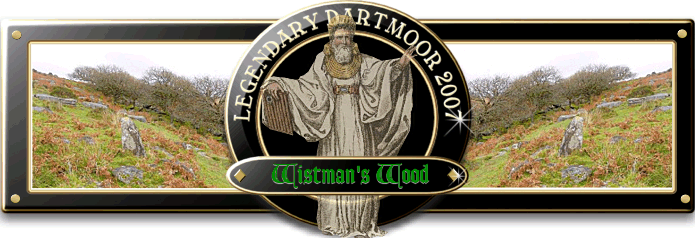
“Scarce hoarier seems the ancient Wood
Whose shivered trunks of age declare
What scath of tempests they have stood
In the rock’s crevice rooted there;
Yet still young foliage, fresh and fair,
Springs forth each mossy bough to dress,
And bid e’en Dartmoor’s valleys share
A Forest-wilderness“.
Sophie Dixon -1829.
PLEASE NOTE: DURING 2020/21 THE NUMBER OF PEOPLE VISITING WISTMAN’S WOOD HAS INCREASED DRAMATICALLY AND IN SOME CASES IRREPAIRABLE DAMAGE HAS BEEN DONE TO THE WOOD AND ITS FLORA. THE WOOD IS BUT ONE OF VERY FEW EXAMPLES OF AN ANCIENT OAK GROVE AND SHOULD BE RESPECTED AS SUCH. PLEASE THINK TWICE ABOUT ENTERING IT AND THE DAMAGE YOU MAY CAUSE – THANK YOU!
Nestled on the eastern slopes of the West Dart river stands a wood of dwarf oak trees. Once you walk into the tangled web of trees you are transported into a mystical world of moss carpeted boulders, lichens of all descript, finger like oak branches, all engulfed in a wonderful smell of earth and age. For millennia this small, mystical, stunted woodland has been held in awe and for many fear. Tales of Druids, ghosts, the Devil and a host of other supernatural creatures abound, some dating back to the long lost ages before man could write. Many writers have described the wood as being “the most haunted place on Dartmoor”, others warn that every rocky crevice is filled with writhing adders who spawn their young amidst the moss and leaf strewn tree roots. Locals will never venture near once the sun begins it slow descent over the nearby granite outcrops for it is when the dark mantle of night draws tight that the heinous denizens of the wood stalk the moor in search of their human victims. So be afraid, very afraid, as the wagging finger of fate warns you to stay clear and risk not your mortal soul in the ‘Wood of the Wisemen’.
Legend has it that Wistman’s Wood was a sacred grove of the Druid’s and it was here that they held there pagan rituals. The huge boulder in the title picture above has become known as ‘The Druid’s Stone’, otherwise called the ‘Buller Stone’. The wood is also said to be the kennels where the diabolical ‘Wisht Hounds‘ are kept. These are a pack of fearful hell hounds who hunt across the moors at night in search of lost souls and unwary traveller’s. It is said that they are huge black dogs with blood red eyes, huge yellow fangs and an insatiable hunger for human flesh and souls. It depends on what part of the moor you meet them but they are either led by the Devil or occasionally by the ancient spirit of Dartmoor known as ‘Old Crockern‘ who lives nearby on Crockern tor. There have been reports from travellers that on dark, misty nights the hounds can be heard howling and baying for blood. The wood is also said to be home to ‘hosts’ of adders who writhe and slither amongst the velvet moss covered boulders, their bites are apparently more venomous that any other adder on Dartmoor. Sometimes the small ghost of a dog called ‘Jumbo’ can be seen scurrying around the rocks and boulders in search of rabbits. At nights, the plaintive cries of the little terrier can be heard echoing down through the valley below. History has it that the poor dog died in the wood, from what nobody is sure but there is a strong possibility that it was from an adder bite. Some people say that the small oak trees never produce acorns but on the other hand people also say that if you carry an acorn from the Druid’s Grove it will protect from rheumatism. Near to the northern edge of the wood is the ancient Lych Way or ‘Way of the Dead’. It was along this track that the corpses were carried for burial at Lydford. There have been reports of a ghostly procession of monastic looking men dressed in white habits slowly walking by the oak wood in sombre silence.
For centuries Wistman’s Wood has been the inspiration for numerous artists and poets and a whole plethora of paintings, etchings and poems have been produced. The noted poet Carrington went into full flow when he penned the following drear lines:
How heavily
That old wood sleeps in the sunshine;- not a leaf
Is twinkling, not a wing is seen to move
Within it;- but, below, a mountain stream
Conflicting with the rocks, is ever heard,
Cheering the drowsy noon. The guardian Oaks,
My country, are thy boast – a giant race
And undegenerate still; but of this grove –
This pigmy grove, not one has climbed the air,
So emulously that its loftiest branch
May brush a traveller’s brow. The twisted roots
Have clasped, in search of nourishment, the rocks
And straggled wide, and pierced the stony soil:-
In vain, denied maternal succour, here
A dwarfish race has risen. Round the boughs,
Hoary and feeble, and around the trunks,
With grasp destructive, feeding on the life
That lingers yet, the ivy winds, and moss
Of growth enormous. E’en the dull vile weed
Has fixed itself upon the very crown
Of many an ancient oak; and thus, refused
By Nature kindly aid, – dishonour – old –
Dreary in aspect – silently decays
The Lonely Wood of Wistman!”
It is interesting to see what the early topographical writers had to say about Wistman’s Wood, one of the earlier descriptions comes from the Reverend J. Swete and was written in 1797. It appears that he was not too impressed with the place:
“It is hardly possible to conceive any thing of the sort so grotesque as this Wood appears, with their branches just spreading themselves over the enormous blocks of granite among which they are intermingled; and their upper lateral roots twisted around their bases, and in the most fantastic wreathings insinuated, whereon a recess, or interstice offered themselves – from the visible decay of their branches, their having long ceased to produce acorns, and the encroachments of the Moss, their destiny seems to be near, and in the 4th part of a Century, they may be conceived to say “Actum est Nobis” – indeed this Moss, (in the common way so injurious to trees) must in the voluminous mass in which it is here found, have hastened on the ruin of the trees… Silence seemed to have taken up her abode in this sequestered wood – and to a superstitious mind some impression would have occurred approaching to dread, or sacred horror..” Swete, 2000, p.71.
From this diatribe one would possibly get the impression that he found the wood a bit daunting and maybe even a trifle un-nerving. Another author gave his views on Wistman’s Wood, writing in 1640, Tristram Risdon said: “In the Forest (of Dartmoor) are three remarkable things: the first a high rock, called Crocken Torr… the second is Childe’s of Plymstock’s tomb … The third is some acres of wood and trees, that are a fathom about, and yet no taller than a man may touch to top with his hand, which is called Wistman’s Wood”, Risdon, 1970, pp. 222 – 3.
Twenty six years later in 1836 Eliza Bray added what was to be a much repeated theory as to Wistman’s Wood, namely the Druidical context. She virtually devotes a whole chapter to the Druids on Dartmoor, much of it coming from the early antiquarian belief than the prehistoric ritual monuments on the moor were in fact the temples of the Druids. In this light she describes a visit to Wistman’s Wood accompanied by a moor farmer as her guide: “… on the south side, we find a spring of the clearest and the purest water, which Hannaford, the farmer, tells us never fails. It bursts from beneath a rock, and, like most of the blessings of Providence (whether we avail ourselves of them or not) it still pours its limpid fountain in fruitful abundance, amidst the wildness and desolation of the spot, and nourishes a thousand beautiful mosses and flowers, that render the Moor, though a desert in one sense of the word, a rich wilderness for Flora, and her train. We now view with surprise the oaks before us: and such is their singular appearance, that, without stopping to reason upon the subject, we are all disposed to think that they are really no other than the last remnant of a Druid grove; or rather the last vestige of its posterity…The ascent to Wistman’s Wood is strewn all over with immense masses of granite, that lie scattered in every direction. The soil about these rocks is very scanty, and appears, the same as in many other parts of the Moor, to be composed of decayed vegetable matter. In the midst of these gigantic blocks, growing among them, or starting, as it were, from their interstices, arises wildly, and here and there widely scattered, a grove of dwarf oak trees. Their situation, exposed to the bleak winds, which rush past the side of the declivity on which they grow, and through the valley of the Dart at their base, (a valley that acts like a tunnel to assist the fury of the gust) the diminutive height of the trees, their singular and antiquated appearance, all combine to raise feelings of mingled curiosity and wonder. The oaks are not above ten or twelve feet high, thus stunted is their growth by the sweeping winds to which they stand exposed; but they spread far and wide at their tops, and their branches twist and wind in the most’ tortuous and fantastic manner… In some places these branches are literally festooned with ivy and creeping plants; and their trunks are so thickly embedded in a covering of fine velvet moss, that at first sight you would imagine them to be of enormous thickness in proportion to their height. But it is only their velvet coats that make them look so bulky; for on examination they are not found to be of any remarkable size. Their whole appearance conveys to you the idea of hoary age in the vegetable world; and on visiting Wistman’s Wood it is impossible to do other than think of those ‘groves in stony places,’ so often mentioned in Scripture as being dedicated to BaaI and Ashtaroth… Many of the immense masses of granite around and under the trees are covered with a cushion of the thickest and the softest moss; but to sit down upon them would be rather too hazardous; since such a seat might chance to disturb from their comfortable bed a nest of adders that are very apt to shelter in such a covert, and few persons, now-a-days, would feel quite so confident as honest Hannaford in the power and efficacy of the ashen wand to render them innocuous. The oaks, though stunted and turning from the west winds, to which they are most exposed, are by ‘no means destitute of foliage; and the good-natured farmer cuts me down a branch to carry home’ in triumph, after having achieved the adventure of a visit to Wistman’s Wood. This branch has upon it several acorns, the smallest I ever saw; but the leaves are of the usual size, and as vigorous as most other trees of the same kind”, Bray, 1836, pp. 97 – 102.
She then quotes some remarks made by her husband as to the date of Wistman’s Wood: “Tradition relates that Wistman’s Wood was planted by the celebrated Isabella de Fortibus, Countess of Devon. But I do not hesitate to say that, to any one who has visited the spot, it is evident no other hand has planted it than that of God. No one would or could have planted trees in the midst of such rocks [e]. They unquestionably can be no other than the remains of the original forest; which, though in its original acceptation … At the late Visitation at Tavistock, on the 31st of. May, Archdeacon Froude, a gentleman possessed of considerable antiquarian information, told me that he had lately obtained part of a tree from this wood, with a view, if possible, to discover its age by the number of circles from its centre to the circumference; that, by the aid of a microscope, he had counted some hundreds, but that at times the divisions were so minute as hardly to be distinguishable; that, different from any other trees he had ever seen, the circles were more contracted, and in a manner condensed, on one side than on any other; and that he supposed this was the side the most exposed to the beat of the weather”, Bray, pp. 102 -3.
The fact that as Mr. Bray stated, a tree sample was taken is confirmed in ‘letters of stone’ because on a large boulder now known as the ‘Buller Stone’ is carved the following: “By permission of H. R. H. the Prince of Wales, Wentworth Buller, on September 16th 1866, cut down a tree near this spot; it measured nine inches in diameter, and appeared to be about one hundred and sixty-eight years old“, – see ill. Crossing, 1987, p.22, notes how a section of this trunk was sent to the Albert Memorial Museum at Exeter and that Mr. F. R. Rowley, the curator confirmed that in 1871 Wentworth Buller sent a vertical and transverse section of such a tree to the museum. This would mean that the sample Bray was referring to must have been another tree as it was taken at least 35 years earlier than the one Buller cut down. According to Martin, 1958, p. 61, another section of this tree was preserved in the Timber Museum at Kew Gardens. He also cites Miller Christy’s age calculations which equate to a tree with a 4½ inch radius being taken to be 163 years old or showing 38 years of growth per inch. Therefore at the time the biggest tree recorded had a 13 inch radius which according to the formula meant the tree was 471 years old which in today’s terms would put the same tree at over 500 years old. Burnard, 1986, p. III 62, remarks, “there is therefore good evidence that some of the smaller trees are not two centuries old, but some of the larger examples are without doubt of much greater antiquity.
In 1866, a fire damaged some of the centre of Wistman’s Wood but as Crossing, p.22 reassures, nature soon repaired the damage and the wood returned to its, “former appearance” within a few years. Of a slightly older date, Baring Gould states that; “In July, 1882, the central portion of the wood was set fire to, it was thought by trippers in an attempt to boil a kettle.” p.172. Whether this was the same fire or another is unsure. One question that is often asked is, “whether the wood is still growing in area”, and this can be answered by looking at the comparison photo below. The black and white photo was taken in 1889 and shows the Buller Stone, the colour photograph of the same stone was shot in 2005. No trees can be seen in the 1889 picture whereas the 2005 shot clearly shows trees growing around the stone, so yes the wood is expanding and growing in area.
There can be no question that by the late 1800s Wistman’s Wood was becoming a most popular place for visitors to visit. The favourite route to the wood meant passing through the old Crockern farmyard and it seems that in 1887 the children living there soon realised there was a lucrative business to be had primarily as gate keepers. The follow account of such a journey demonstrates exactly how adept they were at ‘cadging’: ” The road to Wistman’s Wood from Two Bridges lies up the valley, by a road that passes through a little farm-yard, and then over the hillside through a gate in a rough stone wall. Passing up the road, when I cam to the farm-yard, the gate was opened by a little girl. She didn’t ask for a copper, but she evidently expected it, and got it. About 50 yards further on the re was another gate leading out of the yard upon the hill-side, and here her brother was stationed to act as a porter. Well, this looked a little to much like a business, so, without a “thank-you” we passed on. About 300 or 400 yards further on, the track leads through a gate in the rough stone wall afore said; and there we saw another lad lying in wait. This, however, was too much. I had not got even a “thank you”
left for such pertinacious ‘cadging’; so as there was another gate in the wall about 100 yards further up the hill, we made for that. As we suspected, the boy bolted off thither at once; an we could see him running – through the crevices. Well, he got to the upper gate; and then I turned as if, after all, I meant the lower. Back he belted once more, full speed, we leisurely strolled along, on a parallel, until he had reached his original ‘cache’, when we turned and went through the upper gate after all, before he could return.” – The Express & Echo, June 15th, 1887.
In 1895, Page, p.161, portrays Wistman’s Wood in an almost reverential manner when he says: “From whichever side approached, rough boulders and soil more or less soft are almost inevitable. But having once reached it, the explorer will see a spectacle not easily forgotten, especially if the time be evening, or the sullen clouds lowering upon the waste, when the intense silence is only broken by the murmur of water in the valley beneath, where Dart ‘fleeteth through the moor with a long solitaire course’. As he stands there in the gray light, with no trace of life visible, he may be pardoned if a feeling of something very like awe take possession of the soul, for he will almost expect to see the wraith of some Druid priest gliding along the steep hillside“.
In 1903 the ever optimistic writer Eden Phillpotts devoted a whole chapter of lyrical praise to Wistman’s Wood in his book, ‘My Devon Year’. This small extract describes the flora and fauna of the wood: “The old trees, whose average height is scarcely fifteen feet, are distorted, cramped, twisted, and knotted by time. Their mossy limbs. low spread, make a home for the bilberry, whose purple fruit ripens beside the acorns; for the polypody (fern) that fringes each gnarled limb with foliage; for the rabbits, who leap from the stones to the flat boughs spread upon them; and for the red fox, who, sunning himself in some hollow of moss and touchwood, wakes, as a wanderer assails his ear or nose, and vanishes like a streak of cinnamon light into the depths of the wood. Here, too, the adder rears her brood; the crow with intermittent croak flies heavily; a little hawk, poised in the sky, seeks the lizard below, or the young plover in the marsh upon the hills“, Phillpotts, 2001, pp 185 -186.
Having now brought up the question of the wood’s age it seems apparent that even in the early 1800’s there was no question that the trees were ancient. As can be seen there was this theory that the wood served as an ancient sacred grove of the Druids and this can neither be proven or disproven. The first point to consider in modern terms, is the age of Wistman’s Wood. Gerrard, 1997, p.25 suggests that the pollen record for Dartmoor shows that at the beginning of the Mesolithic period (c.10,000 – 4500BC) it was largely open heathland with small pockets of willow and birch located in sheltered sites. As the climate improved following the last Ice Age, growing numbers of deciduous trees such as oak, elm and hazel established themselves. By 7,00BC most of Dartmoor was wooded. this population remained fairly static until about 5,000BC when the pollen record shows a sudden entry of bracken, grasses and weeds. This is accompanied by evidence for a proportional decrease in woodland at the tree line. The most probable reason for this deforestation is fire and is supported with the recovery of charcoal from the Black Ridge and Pinswell areas of Dartmoor. These changes are recorded elsewhere in Britain and the consensus of opinion is that the fires were deliberately started by humans. Many archaeologists consider that if a clearing of woodland was created by burning, the regeneration of grazing plants would create grazing areas that would attract wild game, this in turn would make it easier for the Mesolithic hunters to catch and kill the animals. Francis Pryor, 1999, p.31 states that: “Hunters made numerous clearings in the forest to encourage the growth of succulent shrubs, grasses and other non woody plants. Animals came to these clearings, which were often placed near watering places and the hunters could take what they pleased, when they pleased; in other words, by carrying out certain not very radical management measures, hunters could attract their prey to a spot convenient to them.”
This idea of determined land management progressed through to the Neolithic period. In fact woodland clearance greatly increased as there was a transgression from hunter gatherers to farmers took place. Gerrard, p.27 considers that on Dartmoor environmental evidence from the peat bogs shows that deciduous woodlands were being cleared and replaced with cultivated areas where crops were being grown. So, if the general trend was for woodland clearance where did that leave Wistman’s Wood. If you look at a map of the area you cannot help noticing the large amount of Bronze Age features. Butler, 1991, p.60 notes that the “ancient grove of oak trees” are a survival of the forests that once spread up the valleys and must have been a “familiar environment to the early Dartmoor farmers”. So it is more than likely that much of the woodland had been cleared but the interesting question is why did the small Wistman’s Wood survive? Simmons, 1965, pp 232-3 poses the same question and offers an explanation. He says “if it was not chance then possibly the aura of mystery surrounding Wistman’s Wood may have ensured its survival.” Could it have been that right from the time of Dartmoor’s prehistoric settlers Wistman’s Wood was held in special regard? There can be no question that the area around the wood has seen a whole series of settlement and land uses, as can be seen from the map. The distribution of prehistoric features are mainly Bronze Age and are clustered around the valley sides of the wood. Butler, 1991, p.60 estimates that there are 18 small enclosures and 80 huts found on the eastern slopes of the valley below Longaford and Littaford tors. Roughly half of the huts are free standing with the rest being constructed around the enclosure edges. The huts range in size between 2.5 – 5.0m in diameter with the majority falling in the 4.0m size. The entrances tend to be located on the southern side of the structures with the odd one or two still having the jams in-situ. There is one hut located at the southern end of the wood which is considerably bigger than the rest. This one has a diameter of 6.8m and is much more substantially built with its own private enclosure, this would suggest that it is a high status building possibly belonging to a chieftain.
Laying amidst the Bronze Age features are the remains of a late nineteen century rabbit warren known as Wistman’s Warren. This sporting warren only lasted a few years and by the early 1900’s the warren hut was in decay and the buries redundant. Hemery adraws attention to the fact that the Dartmoor author Eden Phillpotts often used to visit the warren house and that his book, ‘The River’.
Wistman’s Wood was designated as a ‘Site of Significant Scientific Interest’ in 1964 and English Nature describe the site thus: “The wood is dominated by Pedunculate Oak Quercus robur and the trees have a gnarled and twisted growth-form, many with their lower branches resting on the clitter which forms the woodland floor. Rowan Sobus aucuparia, Holly Ilex quifolium and Eared Willow Salix aurita also occur. The ground flora is characterised by areas of Bilberry Vaccinium myrtillus, Creeping Soft Grass Holcus mollis, Great Woodrush Luzula sylvatica and Bramble Rubus fruticosus. The fern flora within the wood is diverse; the Filmy Ferns Hymenophyllum tunbrigense, and H. wilsonii occurring here. The epiphytic flora is luxuriant, and lichens are well represented, including the rare Alectoria smithii. Of the numerous species of bryophyte with a western distribution, Antitricha curtipendula is of particular note. Bryophyte mats also occur amongst the clitter.
The remainder of the site and surrounding valley slopes comprise characteristic unimproved acidic grassland incorporating areas of dry heather Calluna vulgaris and Bilberry. There are also areas of Western Gorse Ulex gallii and acidic marshy grassland characterised by Purple Moor Grass Molinia caerulea. Of additional interest are several wet flushes giving rise to mire communities dominated by Soft Rush Juncus effusus and with Bog Mosses; Sphagnum spp., Bog Asphodel Narthecium ossifragum, Round-leaved Sundew Drosera rotundifolia, Lesser Spearwort Ranunculus flammula and Marsh St John’s Wort Hypericum elodes. With the exception of a small fenced area of the wood the whole valley is open to grazing by sheep, cattle and ponies. The turbulent West Dart River courses southwards through the site and there is a representative breeding bird population, including Stonechat Saxicola torquota, Whinchat S. rubetra and Wheatear Oenanthe oenanthe“.
The other facet of Wistman’s Wood that has caused much debate is that or the actual place-name etymology. Mrs Bray considers that: “Wist is the preterit and participle of wis, from pissan, Saxon, wissen, German, to know; and is not at present altogether obsolete, as it is still used in Scripture in this sense. From the same etymon comes also wise: ‘sapient; judging rightly; having much knowledge ‘ — (Johnson’s Dict.) Thus Wissman’s or Wistman’s Wood signifies Silva Sapientium, ‘the wood of wisemen.’ The Druids and bards were unquestionably the philosophers or wise men of the Britons. We may naturally conjecture, therefore, that this was their principal or their last place of assembly; and the many stone circles on Bair-down immediately opposite the wood confirm the opinion” Bray, p.73.
Crossing enters the debate and offer two theories, 1987, pp. 22 -23, firstly that the name stems from usig maen coed which translates as ‘water’ stone wood’. His second suggestion is that the name comes from the Saxon word for the native Devonians, namely Wealas a term that was generally applied to any early native Britain. As these people tended to be concentrated in Wales the term corrupted to Welsh thus, in context of the wood, giving the ‘wood of the Welshmen’. He also notes that in the 1800’s the wood was often referred to locally as the ‘Welshman’s Wood’. Hemery, 1983, p.454, adds weight to this when he cites an early Duchy document dating to 1621 which states: “One place called Welshman Wood where the Tallest Tree is not above the Height of a Man”. Another suggestion from G. M. Spooner is that the name is a local corruption of Wisht-Man’s Wood, this refers to the Devonshire word Wisht meaning pixie-led or haunted. The English Place-Name Society, Gover et al, 1992, p.198, has surprisingly very little to say about the name but seem to concur with Spooner’s Wisht theory.
There can be no question that Wistman’s Wood is a unique and enigmatic feature and as always on Dartmoor has attracted the attention of the letterboxers. Numerous boxes have over the years been sited around the wood all in their own way adding to the mystery and history of the place. You could fill a webpage with the numerous examples of Wistman’s Wood stamps but a few of my favourites can be seen above.
So there you have it – Wistman’s Wood, the last vestige of a prehistoric woodland or I think to be more precise the last vestige of the offspring of a prehistoric woodland. You will read numerous people banging on about woodland spirits and mystical energies but at the end of the day the wood has had one guardian angel – the rocks that scatter its leafy floor. Without them both man and beast would have had easy access to the wood and I am sure would have hewn and grazed their way through the stunted oaks.


 Legendary Dartmoor The many aspects past and present of Dartmoor
Legendary Dartmoor The many aspects past and present of Dartmoor

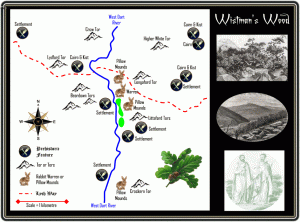
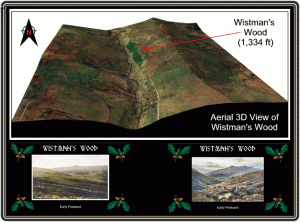
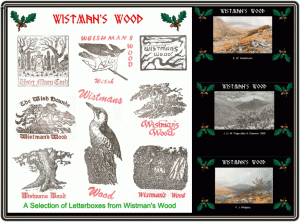
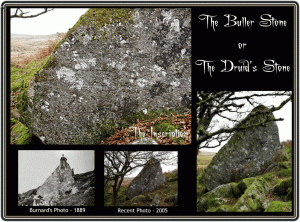
Hi Tim,
This is such a great piece on Wistman’s Wood, I’ve enjoyed reading all the historical excerpts, thank you!
Note, though, that the mention of Wistman’s Wood by Tristram Risdon while published in the 19th century is based on his manuscript from the 17th century. Risdon died in 1640, so his was the first mention of the wood.
See the preface for publication history, Risdon bio, and page 223 for the passage on Wistman’s Wood:
“The chorographical description or survey of the county of Devon. By Tristram Risdon. Printed from a genuine copy of the original manuscript; with considerable additions.”
Available in full at Hathitrust http://hdl.handle.net/2027/mdp.39015009157010
Best wishes, Jane
Hi Jane, many thanks for your comments, I have now amended the page as suggested and thanks for pointing it out.
Hello Tim…Im just wondering if you would mind if I used your words from the first paragraph for a piece of work i would like to write out…I would put your name in full, and that permission has been granted if are willing for me to do this. Thank you
Hi Ruth, no problem, help yourself.
So very kind Tim…Thank you
A really well-researched and exhaustive piece. Thank you. But do you happen to know of a stone marked with a “Celtic” triskele (triple spiral) in the wood? It is reminiscent of the triple spiral pattern in the burial chamber at New Grange, Ireland. It is shown on the cover of a new book, “Britain’s Ancient Forest: Legacy & Lore”, by Julian Hight, and is used again in the book’s section on the wood, but with no further details given. I can find no other online photos of it (although there are some of another mossy boulder where concentric circles have been scraped clean) or any other references to it online. Although it is covered in moss, I wonder whether it my be a relatively modern carving?
Sorry, never seen that before in Wistman’s Wood, the only one I know of was the single version.
We came upon this ancient woodland during our visit to Dartmoor. It was quiet eerie I have use my photographs to produce artwork including the near by river
Dear Tim –
Thank you very much for your latest mailing, for which I am always grateful to receive.
With regard to the notice you posted regarding Wistmans Wood, it is always distressing to hear of the damage caused by visitors to Dartmoor by those who profess to appreciate the Moor but then do their best to desecrate the area in which they camp or to which they visit.
I, for one, would be happy to subscribe for your notice, or something like it, to be displayed at various locations around Dartmoor – suitably amended as necessary.
Again, thank you for your invaluable newsletters.
Sincerely,
Michael Tucker
Liverton